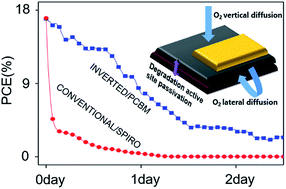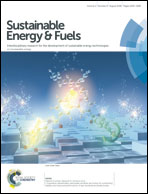Passivation against oxygen and light induced degradation by the PCBM electron transport layer in planar perovskite solar cells†
Abstract
Herein, we investigate the causes of a 20 fold improved stability of inverted, planar structure devices (ITO/PTAA/CH3NH3PbI3/PCBM/BCP/Cu) compared to conventional structure devices (FTO/compact-TiO2/meso-TiO2/CH3NH3PbI3/spiro-OMeTAD/Au) under oxygen and light stress. The PCBM layer is shown to function as an oxygen diffusion barrier and passivation layer against superoxide mediated degradation. The passivation properties of the PCBM layer are shown to depend on the electron affinity of the fullerene acceptor, attributed to the low LUMO level of PCBM energetically inhibiting superoxide generation. We also find that planar structure devices show slower lateral oxygen diffusion rates than mesoporous scaffold devices, with these slower diffusion rates (days per 100 μm) also being a key factor in enhancing stability. Faster degradation is observed under voltage cycling, attributed to oxygen diffusion kinetics being ion motion dependent. We conclude by discussing the implications of these results for the design of perovskite solar cells with improved resistance to oxygen and light induced degradation.

- This article is part of the themed collection: 3rd International Solar Fuels Conference and International Conference on Artificial Photosynthesis


 Please wait while we load your content...
Please wait while we load your content...